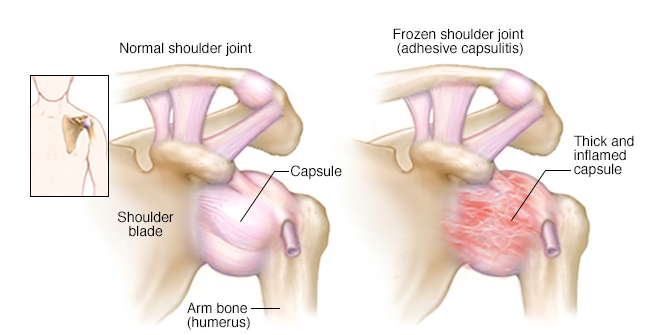Frozen shoulder
Frozen shoulder, also called adhesive capsulitis, is a condition in which the soft tissue capsule that surrounds the glenohumeral joint (shoulder joint) begins to stiffen causing pain and decreased range of motion. The shoulder is a ball-and-socket joint made up of three bones including the humerus (upper arm bone), scapula (shoulder blade), and clavicle (collarbone). The head of the humerus fits into the socket in the shoulder blade where a strong connective tissue, called the shoulder capsule, surrounds the joint. Synovial fluid lubricates the shoulder capsule and the joint to aid in range of motion.

In frozen shoulder, evidence shows synovial inflammation and a dense matrix of type I and III collagen laid down by fibroblasts in the joint capsule. Increased growth factors and cytokines have been biopsied in patients which indicate it also involves an inflammatory condition. The scar formation greatly intrudes upon the space needed for movement within the joint. Frozen shoulder comes on gradually with signs and symptoms worsening over time. There are three main stages in which this occurs. The first is called the freezing stage which occurs when any movement of the shoulder causes pain and the range of motion becomes limited. This stage typically lasts from 6 weeks to 9 months. The frozen stage comes second in which pain may start to diminish. However, the shoulder becomes stiffer and more difficult to use. Lastly is the thawing stage. In this stage, the range of motion begins to improve and the pain can subside. This stage usually occurs 1-3 years after the shoulder becomes frozen.

Although the most recognized pathology is cytokine-mediated synovial inflammation with fibroblastic proliferation, the actual cause of frozen shoulder is not fully understood although there are some identified risk factors. Diabetes patients have a higher risk of developing frozen shoulder although the reason is not known. These patients typically have a greater degree of stiffness for longer periods of time before the thawing stage occurs. Hypothyroidism, hyperthyroidism, Parkinson’s, and cardiovascular disease are all associated with frozen shoulder. Besides for other health conditions, immobilization is thought to play a big role in the development of frozen shoulder. When the shoulder is immobilized for long periods of time such as when an injury like a fracture or surgery like a mastectomy occurs.
There are muscles and tendons that work together in the shoulder to provide stability to the ball and socket joint. The rotator cuff muscles including the subscapularis, supraspinatus, infraspinatus, and the teres minor work together to stabilize the ball of the humerus to the glenoid socket. These four muscles form the rotator cuff that comes together with the tendon around the humeral head and secure it firmly to the socket. The rotator cuff tendon covers the head of the humerus to protect the glenohumeral joint and help raise and rotate the arm. Certain occupations or sports activities can put great demand on the rotator cuff muscles causing muscle injuries with inflammation and scar tissue formation. Patients will experience upper back pain as well as reduced range of motion of the shoulder joint.
Rotator Cuff Injury
A rotator cuff injury is usually a strain or tear involving the tendons and joint capsule of the rotator cuff. This can occur from a single traumatic incident such as a broken collarbone and dislocated shoulder or from degenerative changes. The most common rotator cuff injury is the rotator cuff tear of the supraspinatus tendon due to degenerative changes of the tendon occurred from the preceding tendinosis. Tendinosis of the rotator cuff tendons can be caused by repetitive movements in a sport or daily life such as overhead arm movements, a reduction of blood supply to the region, or poor posture.

Symptoms of a rotator cuff injury typically include recurrent pain especially during certain activities, pain that prevents the patient from sleeping on the injured side, grating or cracking sounds when the arm is moved. The injury can cause decreased range of motion and muscle weakness and therefore patients will experience similar difficulty in lifting their arms and moving their shoulders that occurs in a frozen shoulder condition.











